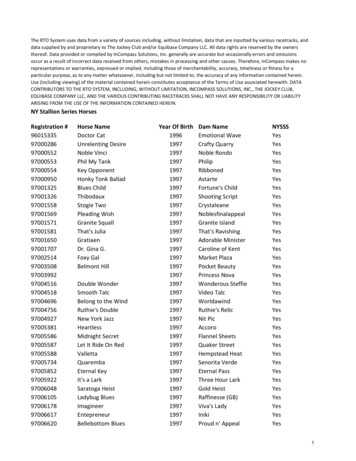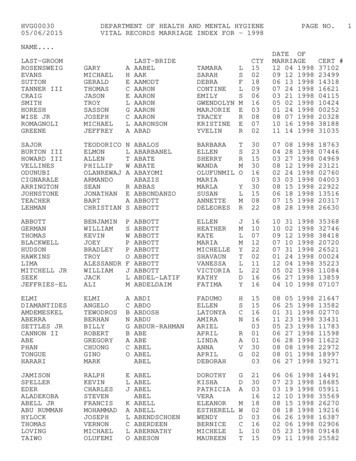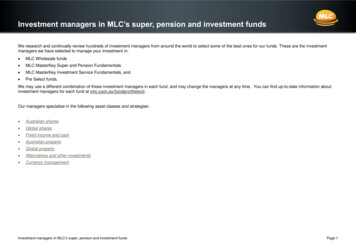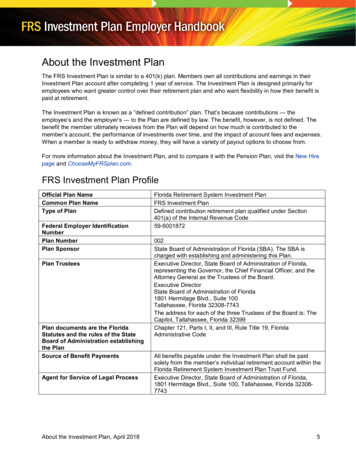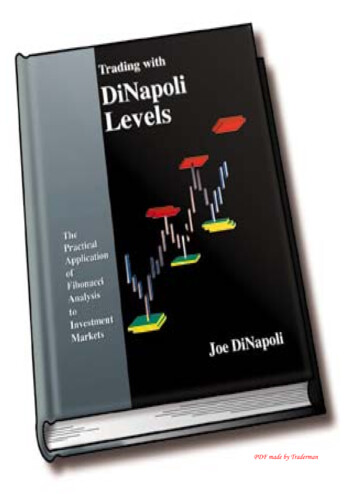
Transcription
PDF made by Traderman
Copyright 1998, Coast Investment Software, Inc. and Joe DiNapoliALL RIGHTS RESERVED. No part of this publication may be reproduced, stored in a retrievalsystem, or transmitted, in any form or by any means, electronic, mechanical, photocopying,recording, or otherwise, without the prior written permission of the copyright holder.This publication is designed to provide accurate and authoritative information in regard to thesubject matter covered. It is sold with the understanding that the authors and the publisher arc notengaged in rendering legal, accounting, or other professional service. If legal advice or otherexpert assistance is required, the services of a competent professional person should be sought.ISBN: 1-891159-04-6Printed in the United States of AmericaWarning and Disclaimer:In commodity trading, as in stock, and mutual fund trading, there can be no assurance of profit. Lossescan and do occur. As with any investment, you should carefully consider your suitability to trade and yourability to bear the financial risk of losing your entire investment. It should not be assumed that themethods, techniques, or indicators presented in this book will be profitable or that they will not result inlosses. Past results are not necessarily indicative of future results. Examples in this book are foreducational purposes only. This is not a solicitation of any order to buy or sell.The information contained herein has been obtained from sources believed to be reliable, but cannot beguaranteed as to accuracy or completeness, and is subject to change without notice. The risk of using anytrading method rests with the user.A portion of the above notice is from a Declaration of Principles jointly adopted by a Committee of theAmerican Bar Association and a Committee of Publishers.The NFA requires us to state that, "HYPOTHETICAL OR SIMULATED PERFORMANCE RESULTSHAVE CERTAIN INHERENT LIMITATIONS. UNLIKE AN ACTUAL PERFORMANCE RECORD,SIMULATED RESULTS DO NOT REPRESENT ACTUAL TRADING. ALSO, SINCE THE TRADESHAVE NOT ACTUALLY BEEN EXECUTED, THE RESULTS MAY HAVE UNDER-OR-OVERCOMPENSATED FOR THE IMPACT, IF ANY, OF CERTAIN MARKET FACTORS, SUCH AS LACKOF LIQUIDITY. SIMULATED TRADING PROGRAMS IN GENERAL ARE ALSO SUBJECT TOTHE FACT THAT THEY ARE DESIGNED WITH THE BENEFIT OF HINDSIGHT.NOREPRESENTATION IS BEING MADE THAT ANY ACCOUNT WILL OR IS LIKELY TO ACHIEVEPROFITS OR LOSSES SIMILAR TO THOSE SHOWN."The following notice applies when the names cited below are mentioned throughout the book.FibNodes, DiNapoli Levels, Oscillator Predictor, and D-Levels are trademarks of Coast Investment Software, Inc.Windows is a registered trademark of Microsoft Corporation.Aspen Graphics is a trademark of Aspen Research Group, Ltd.TradeStation is a registered trademark of Omega Research, Inc., PowerEcitor is a trademark of Omega Research Inc.MetaStock is a trademark of Equis International.CQG TQ20/20 is a trademark of CCG, Inc.Market Profile is a registered trademark of CBOT.Advil is a registered trademark of American Home Products Corporation.Maalox and Pampers are registered trademarks of The Procter & Gamble Company.Grecian Formula is a registered trademark of Combe Inc.
DEDICATIONThis book is dedicated to my Father and Mother, Joe and Olivia DiNapoli,without whose love, persistent guidance, and care, nothing would havebeen possible.
ACKNOWLEDGMENTSThe production of this book was a daunting task. Its completion would not havebeen possible without the help of many. My deepest appreciation and thanks to:Pat Prichard for her forbearance, diligence, love and strength.Lee and Dave Winfield for their generosity, their talent, and their time.Elyce Picciotti and Steve Roehl for their many technical skills and an attitudethat allowed me to utilize them.Tim Slater, Nea! Hughes, and Dian Belanger for their unselfish guidance inmaking this project better.My wonderful students and clients for teaching me and encouraging me to beginthis project.Dan, Hank, and Carl for adding life to these pages.Aspen Graphics for their permission to reproduce charts from their excellentgraphics software.My peers, some who wish to remain anonymous, many of whom gounmentioned. Thank you for sharing your knowledge with me openly andwithout condition: Larry Pesavento, Jake Bernstein, Bill Williams, Steve Conlon,a Chicago floor manager whose name I have long since forgotten, but who wasotherwise known as "God," and last but not least, Robert Krausz.V
TABLE OF CONTENTSABOUT THE TITLExivPREFACE or SO WHY THIS BOOK AND WHY NOW?xvSECTION 1: INTRODUCTIONCHAPTER 1TRADING METHODSJUDGMENTAL VS. NON-JUDGMENTAL TRADING SYSTEMSPOSITION TRADING VS. INTRADAY TRADINGGENERAL DISCUSSIONLET'S DO A REALITY CHECKNON-JUDGMENTAL TRADING APPROACHESWOULDN'T IT BE NICETHE REALITY.JUDGMENTAL TRADING APPROACHESWOULD IT BE NICETHE REALITYSOME HISTORYHEROESSYSTEM FAILUREAPPRENTICESHIPMORE ON JUDGMENTAL TRADING APPROACHESSUMMARYASPECTS OF JUDGMENTAL TRADINGASPECTS OF NON-JUDGMENTAL TRADINGASPECTS OF NON-JUDGMENTAL AND JUDGMENTALTRADINGPOSITION TRADING VS. INTRADAY TRADINGDISADVANTAGES OF INTRADAY TRADINGADVANTAGES OF INTRADAY TRADINGAN ALTERNATIVEVI3344446667889101313131415161617
CHAPTER 2PREREQUISITES,GROUND RULES AND DEFINITIONSTRENDDIRECTION.MOVEMENTFAILURELEADING INDICATORS.LAGGING INDICATORSLOGICAL PROFIT OBJECTIVESTIME FRAMECONFIRMED & UNCONFIRMED SIGNALSMISTAKESTRADING WELLTHE TRADING PLANSUMMARY.1919252525272729292930303030CHAPTER 3THE ESSENTIAL COMPONENTSOF A SUCCESSFUL TRADING APPROACH31MONEY AND SELF MANAGEMENTMARKET MECHANICSTREND AND DIRECTIONAL ANALYSISOVERBOUGHT AND OVERSOLD ANALYSISMARKET ENTRY TECHNIQUES (LEADING INDICATORS)MARKET EXIT TECHNIQUES (LEADING INDICATORS)IMPORTANT POINTS TO NOTE32333434343434SECTION 2: CONTEXTCHAPTER 4:TREND ANALYSISDISPLACED MOVING AVERAGES.37GENERAL DISCUSSIONDISPLACED MOVING AVERAGESADVANTAGES AND USESPECIFIC VALUES DEFINEDTIME FRAME APPLICABILITYFREQUENTLY ASKED QUESTIONS.ADVANCED COMMENTS.37.38.38.38.38.39.41vii
CHAPTER 5TREND ANALYSISMACD/STOCHASTIC COMBINATIONGENERAL DISCUSSIONPROGRAMS, PROGRAMMERS, AND PROBLEMSWILL THE RIGHT STOCHASTIC STAND UPLANE (RAW) STOCHASTICFAST STOCHASTICSSLOW (PREFERRED) STOCHASTICSMODIFIED MOVING AVERAGEMODIFIED STOCHASTICTHE STOCHASTICTHE PREFERRED STOCHASTICMARKET-ALIGNED VS TIME-ALIGNED BARSTHE DATA SAMPLEPROGRAMMERS AND UPGRADESUSING THE STOCHASTICIMPLEMENTING THE MACD (DEMA) STOCHASTICCOMBINATIONFREQUENTLY ASKED 69CHAPTER 6DIRECTIONAL INDICATORS9 POWER PATTERNS FOR HIGH PROBABILITY TRADINGSIGNALS71GENERAL DISCUSSION71THE "DOUBLE REPENETRATION" SIGNAL OR "DOUBLE REPO".72IMPORTANT POINTS TO NOTE74FREQUENTLY ASKED QUESTIONS76THE "DOUBLE REPO FAILURE"86FREQUENTLY ASKED QUESTIONS87THE "SINGLE PENETRATION" OR THE"BREAD AND BUTTER" SIGNAL90PATTERN FAILURES94' THE "HEAD AND SHOULDER FAILURE"94THE "TRIANGLE BREAKOUT FAILURE" OR "OOPS"97"FADING POPULARITY" OR "THE VULTURES DELIGHT"98THE "RAILROAD TRACK"98"LOOL-ALIKES"105"STRETCH"105THE "FIB SQUAT"105FILTERING THE "FIB SQUAT"108FREQUENTLY ASKED QUESTIONS109viii
CHAPTER 7OVERBOUGHT & OVERSOLDOSCILLATORS: WHAT WORKS, WHAT DOESN'T,AND WHY111GENERAL DISCUSSIONTHE STOCHASTICTHEMACDTHE RELATIVE STRENGTH INDEX (RSI)THE COMMODITY CHANNEL INDEX (CCI)THE DETRENDED OSCILLATORUSING THE DETRENDED OSCILLATORVOLATILITY BREAKOUTIMPORTANT POINTS TO NOTETHE OSCILLATOR PREDICTOR CONTEXTCHAPTER 8FIBONACCI ANALYSIS, BASICGENERAL DISCUSSIONA LITTLE HISTORYDERIVATIONGUIDE POSTSBASIC RETRACEMENT ANALYSIS UTILIZING THE TWO MAJORRATIOS .382 AND .618BASIC FIBONACCI EXPANSION ANALYSIS UTILIZING THETHREE MAJOR EXPANSION RATIOS .618, 1.0, AND 1.618FREQUENTLY ASKED QUESTIONSCHAPTER 9DINAPOLI LEVELS INTRODUCTION & CAUTIONSELLIOTT WAVE PRINCIPALDINAPOLI LEVELS DEFINITIONSMARKET SWINGREACTION NUMBER or POINTFOCUS NUMBERFIBNODEorNODEOBJECTIVE 146146146ix
CONFLUENCELINEAGE MARKINGSLOGICAL PROFIT OBJECTIVEAGREEMENTFIB SERIESDINAPOLI LEVELS OR D-LEVELS EXAMPLESIMPORTANT POINTS TO NOTETHE PROPORTIONAL DIVIDER.CHAPTER 10DINAPOLI LEVELS MULTIPLE FOCUS NUMBERS & MARKET SWINGSMULTIPLE MARKET SWINGSADVANCED COMMENTSEVEN MORE FOCUS NUMBERSTIME FRAME'S IMPACT ON FOCUS NUMBERSLESS IS MOREPRUNING THE FIB SERIES:ELIMINATING INACTIVE FIBNODESCHAPTER 11TRADING WITH DINAPOLI LEVELS 170173GENERAL DISCUSSION173MOVING THE TIME FRAME,.173AN IDEALIZED TRADING EXAMPLE176ADVANCED COMMENTS179D-LEVEL EXPANSION ANALYSIS & LPOs179MORE ON STOP PLACEMENT184PRESENTATION188FIBNODES PRINTOUTS189DOW EXAMPLE192FIBNODES OBJECTIVE PRINTOUTS194AGREEMENT ON THE BOND CONTINUATION195HIDDEN D-LEVELS 197ADVANCED COMMENTS201'USING FIBONACCI ANALYSIS TO DEFINE MARKET MOVEMENT. 203CHAPTER 12TYING IT TOGETHERA BASIC EXAMPLESCENARIO 1SCENARIO 2ADVANCED COMMENTSNOW LET'S GET BACK TO REALITYFREQUENTLY ASKED QUESTIONSx205207210211215215
CHAPTER 13FIBONACCI TACTICSGENERAL DISCUSSIONBONSAI:AN ENTRY AND STOP PLACEMENT TECHNIQUEBUSHES:AN ENTRY AND STOP PLACEMENT TECHNIQUEMINESWEEPER A:AN ENTRY AND STOP PLACEMENT TECHNIQUEMINESWEEPER B:AN ENTRY AND STOP PLACEMENT TECHNIQUEENTRY TACTICS USED ON AN HOURLY S&PTHE TRADE CONTINUESWASH AND RINSE: A CONFIDENCE BUILDERFREQUENTLY ASKED QUESTIONSCHAPTER 14AVOIDING A TYPICAL MISTAKEGENERAL DISCUSSIONYEARLY BOND EXAMPLETHE BROADER PICTURE:D-LEVELS ANALYSIS AND REAL ESTATE MARKETSA QUESTIONCHAPTER 15MORE MARKET EXAMPLESA LONG TERM SOYBEAN MEAL TRADEGENERAL DISCUSSIONTHE CONTEXT FOR THE TRADETRADE IMPLEMENTATIONTHE TRADE CONTINUESIMPORTANT POINTS TO NOTEADVANCED COMMENTSWAS A MISTAKE MADE?MORE EASY PICKENSA SHORT TERM S&P TRADEGENERAL DISCUSSIONTREND ANALYSISOVERBOUGHT AND OVERSOLD ANALYSISDIRECTIONAL ANALYSISTRADE IMPLEMENTATIONTHE TRADE PSYCHOLOGYHOW MARKET MECHANICS AFFECT THIS TRADEADVANCED 2262264264265267268271273xi
APPENDIXAPPENDIX ACALCULATIONS AND CHART LOCATION FOR THE 3X3DISPLACED MOVING AVERAGEDEFINITIONEXAMPLE275275275APPENDIX BRUNNING FIBNODES AND TRADESTATION ATTHE SAME TIMEWINDOWS 3.1 USERSWINDOWS 95 USERS,276276276APPENDIX CFIBNODES SETUP FOR ASPEN GRAPHICS USERSWINDOWS 3.1WINDOWS 95TO OVERLAY FIBNODES ON ASPEN GRAPHICS TO VIEW FIBNODES AND ASPEN GRAPHICS SIDE-BY-SIDE("TILED" ON YOUR SCREEN)277277278278278APPENDIX DTRADESTATION INPUTS TO SIMULATE STUDIES TAUGHT INDINAPOLI LEVELS .279MOVING AVERAGE CONVERGENCE DIVERGENCE (MACD)279DISPLACED MOVING AVERAGES279DETRENDED OSCILLATOR279PREFERRED STOCHASTIC280. PREFERRED SLOW %D USER FUNCTION280„ PREFERRED STOCHASTIC INDICATOR281PREPROGRAMMED TRADESTATION STOCHASTICINDICATORS AND FUNCTIONS281xii
APPENDIX EFORMULAS AND STUDIESLANE FAST STOCHASTICFAST STOCHASTICFAST STOCHASTIC USING THE MODIFIED MOVING AVERAGE(MAV) FOR SMOOTHINGFAST STOCHASTICSTHE PREFERRED (SLOW) STOCHASTICMOVING AVERAGE CONVERGENCE DIVERGENCE (MACD)FORMULAEXPONENTIAL MOVING AVERAGES283283283284284284285285APPENDIX FFIBNODES HOW FIBNODES WORKSOPERATING SYSTEMFIBNODES REQUIREMENTSCOSTFIBNODES FEATURES286286286287287288APPENDIX GTHE OSCILLATOR PREDICTOR OPTION 1: USER SELECTS OSCILLATOR PROGRAMCALCULATES PRICETHE OSCILLATOR PREDICTOR AS APPLIED TOTHE SHORT TERM S&P TRADE289289291APPENDIX HSHORT TERM S&P TRADE, FROM CHAPTER 15, TIME & SALES,(AFTER THE "HEAT OF BATTLE")294APPENDIX ICONTINUOUS CONTRACT CREATION295APPENDIX JCOAST INVESTMENT SOFTWARE, INC.PRODUCTS & SERVICESBIBLIOGRAPHYREFERENCE MATERIALABOUT THE AUTHOR296„297298301xiii'
ABOUT THE TITLE:The term DiNapoli Levels was coined by an Australian copywriter doing pre-conferencepromotion work on one of my speaking tours in Asia. It seemed appropriate and theattendees thought the title gave them a good indication of what the presentation wasabout. I also have to thank my contemporaries John Bellinger (Bellinger Bands), LarryWilliams (Williams %R), George Lane (Lane Stochastics), and numerous others for givingme the fortitude to proceed with such a title. In the final analysis, however, I have toadmit that this title was given serious consideration only after a certain individual managedto call successive market highs and lows after himself and. not only survived butprospered in doing so.
PREFACEIf you want a bit of background before we get involved in all the technical matters,continue to read. Otherwise, you can jump right to CHAPTER 1 or even CHAPTER 2,without jeopardizing your understanding of my approach to trading.So why this book and why now? Or more broadly put, "Why would you reveal a tradingmethod that really works? Why not just trade it? Aren't you afraid that if too manypeople use it, it won't work any more?" Reasonable questions that deserve answers. Theshort answer is that the markets have been kind to me, affording me considerable mobilityand a comfortable life style. I was also recently faced with a life-threatening medicalcondition. Such an event gives one cause to think. Creating this book allows me to givesomething back. The long answer involves a bit of history.In 1986 I experienced a severe case of emotional and physical burnout, brought on byover-trading and lack of sleep. I squandered my health and well-being for money andaccolades from my peers. I learned then that there were more important aspects to lifethan the next tick of the S&P. On counsel from my friend, Jake Bernstein, I took a shot atthe lecture circuit. It was late in 1986 in Las Vegas at the Futures SymposiumInternational. I was totally unprepared for the response of the attendees.The lectures were organized in two, one-hour segments, one in the morning and the otherin the afternoon. I had been advised by one of the old time pros: "Give 'em an up, down,up, close, and buy. Keep it simple," he had said. "They won't understand or appreciateanything of value." "But that's not the way I trade," was my response. "So what," hemuttered. I was surprised at his degree of cynicism. When I asked Jake, the eventorganizer, what he thought should be covered, his response was direct and simple. "Teachwhat you think you should. If the attendees don't like it, it's their loss." Well, that'sexactly what I did. There were about 35 people in the morning workshop. Their interestwas keen, their questions were intelligent and I thoroughly enjoyed sharing my knowledge.That afternoon I spoke again. This time, the room was filled to capacity. Peoplecommandeered chairs from the hallway and other rooms. They were sitting in the aisles,on the floor, some were on top of tables at the back of the room and there were perhapsanother 50 people outside the door trying to get in. About 20 minutes into the lecture, anargument broke out between those who wanted a relatively simple question answered andthose who wanted me to go on. Time was very limited, and it was all I could do toprevent a brawl.xv
When the workshop was over, Pat my office manager, and George Damusis myprogrammer, were mauled for more information. Workshop attendees wanted anythingthey could get. We had our end-of-day graphics software (the CIS TRADING PACKAGE)which handled the trend and oscillator aspects of the lecture, but we had almost nothingon the style of Fibonacci analysis that I had taught. Fortunately we did have someFibNodc software manuals. These did a good job of teaching Fibonacci, DiNapoli-style,and along with a few beta copies of the software, everything was gone, and I mean gone!The next several years were loaded with speaking engagements, TV appearances,interviews, offers to manage money, possibilities to start a newsletter, fax services, and soon. While I welcomed the success, thoroughly enjoyed the teaching, and met someoutstanding people along the way, it was all becoming a little overwhelming. I was alsoexperiencing a gnawing fear that if what I had developed was overexposed, it could affectthe market, my personal trading, and of course the trading of my students. To combat thispossibility, I steadfastly refused to publish a book, manage money, publish any type ofnewsletter, or even to advertise! On three occasions I insisted on halting lectures in whichthere was unauthorized video taping going on. I even shelved a full video course shot at atwo-day presentation sponsored by Coast in 1990, again fearing overexposure of thematerial.In an effort to maintain a reasonable balance, however, I created theFIBONACCI, MONEY MANAGEMENT AND TREND ANALYSIS in home trading course.I also continued development of the FibNodes software, and enhanced the CISTRADING (graphics) PACKAGE. In addition, I offered some private seminars, where thenumber of attendees was strictly limited.I am going through this background history to make a couple of very important points.Unlike many of my colleagues, I believe the concern of overexposure of a tradingmethodology - even one that has judgment involved - is a valid and reasonable concern.There's also a philosophical point to be made. Any professional who tries to be all thingsto all people, and to produce products wherever there is demand, ultimately experiencesburnout. That burnout is readily evidenced in his work. I prefer to retain my focus.Even with limited exposure, I was witnessing an effect in the market from about mid 1987through 1990 which I believe was directly attributable to my lectures. While this effectwas muted, it was nonetheless apparent. Let's be honest, if there's something good outthere, it gets around. When it gets around, we need to be watchful. While its usefulnesswill remain significant, it is always possible that the implementation of the strategies maybecome more difficult.From about 1984 to 1987 the Fib analysis, coupled with the all-important context that Iwill teach in this book, was so incredibly accurate, it was scary. By late 1989, massiveorders being set right on Fib retracements and objective points, with stops two or threeticks away, began to wreak havoc with the unqualified Fib players. While I couldxvi
compensate my own techniques for what I was observing, the casual Fib player wasbeginning to get hurt. If a lot of traders get on to something really good, the market willsee to it that the majority will still lose. It has to be that way in order for the market towork.1Fortunately, in December of 1989, Technical Analysis of Stocks & Commodities magazinepublished an article by some professor type with a doctorate in pure mathematics. He dida "study" on the validity of Fibonacci movements in the markets. The study "proved" byirrefutable, geometric, logic to any reasonable cerebral type, that the methodology ofapplying Fibonacci analysis to the markets just didn't work.2I found out about this "authoritative" article while speaking at an economics conference inChicago in 1989. I was with a good friend and client, a professional floor trader, whenseveral attendees excitedly bounded toward us. The first individual was waving a copy ofStocks & Commodities magazine around, all excited about this article, that "thoroughlydisproved" the subject matter of my upcoming lecture.When my client and I figured out what all the excitement was about, we simultaneouslygave each other the trader's equivalent of a "high five." It's something like a war dance.The attendee was not a professional and couldn't comprehend our joy. Why would theFibonacci Guru be happy about an article written in Stock & Commodities magazine, thatmaintained Fibonacci analysis didn't work? Of course, what we hoped as professionals,and what the newcomer couldn't fathom, was that our job as professional traders wasabout to become easier - hopefully a lot easier. Thanks to the difficulty the market waspresenting the casual Fib player and that magazine article, over the next weeks andmonths, that's exactly what happened.So, for me, revealing my trading methodology was a balancing act between the negativeeffect such exposure might have, and the many, many, benefits that ensue from beingrecognized as an authority in one's field of expertise. Many of you who are now simplystriving for that winning trade cannot imagine the doors that expert status in trading opensfor you - not only here in the US, but all over the world!Starting around 1991, I began to shift my focus to Asia. The markets were ripping overthere and I was getting constant input from clients located in Asia and elsewhere aroundthe world that my methods were barbecuing the competition. I've always taught studentsto go where the profits were easiest and I had always wanted to be in Asia, so. I pulledthe plug on all but the best speaking engagements in the US and set out on an exploration1Joe DiNapoli, FIBONACCI, MONEY M4NAGEMENT AND TREND ANALYSIS in home trading course(Coast Investment Software, Inc.).Herbert H. J. Riedel, "Do stock prices reflect Fibonacci ratios?" Technical Analysis of Stocks &Commodities, December 1989.xvii
of all the wonders that collectively are Asia. As a professional, speaking in all the majorcenters, I was able to gain insight into the culture and to gather "competent information"on how the markets functioned in each of the countries I visited. It was a fascinatingexperience. Back in the US, clients were still finding their way to my door, but thenumbers were manageable, and more importantly, the effect on the markets remainedmuted. Now, at this writing in 1997, things are looking pretty good for additionalexposure of the material. There are a number of new Fibonacci experts, some, formerstudents. There has been some good work done. There have also been a few, let's callthem "unworkable" books on the subject. Consider this. If an "unworkable" book iswritten on Fibonacci analysis and people lose money attempting to employ its techniques that's a good thing. Anything that attracts traders away from the utilization of the concept/// its proper form is an advantage to those who are skilled in how to employ it. There willbe less "destructive" activity in price areas important to us.Everyone has his own idea on how this methodology should be applied. Everyone isdoing something different with it. Plainly speaking, this has made it easier for me to tradeand has made it possible for me to wrile this book. The simple truth is, the more peoplewho teach a different or impractical use of Fibonacci analysis, the better it is for me - andfor yoir. The idea that the whole concept will be denigrated entirely is a virtualimpossibility. There are simply too many people making too much money trading it - ifthey know how to apply it properly.Aside from Fibonacci work, the marketplace abounds with new techniques and methods.There are eager new traders with eager new experts to teach, and brand new methods tobe taught. TradeStation and other software packages with their blind system-buildingtechniques, put large numbers of orders in lots more places. All this is good news. Itleads to the likely conclusion that a reasonable understanding of what is contained hereinwill pay big dividends. But beware! If this book catches on in a big way, and // it iswidely followed (unlikely since there is work involved), over time there may be someconsequences. If any methodology is spread too widely spread, the market typically willallow only those who study thoroughly and pay attention to nuances, to fully recognize itstrue potential and promise. In that respect, this approach is no different from others.xviit
SECTION 1INTRODUCTIONThis is a book about a comprehensive and modular trading approach that I have found tobe prudent and highly effective. It is about the PRACTICAL application of Fibonacciratios to investment markets. In order to implement these Fibonacci based strategiessuccessfully, a considerable foundation and structured context must be put in place. Thetext contains 15 information-packed Chapters, a comprehensive set of Appendixes, andReference material, as well as an orientation in the form of a Preface. Fibonaccitechniques are not taught until Chapter 8, so that the ground work can be properly laid.If you choose to gallop ahead, it is my hope that you have already formulated acomprehensive context in which to use the powerful leading indicator techniques,referred to herein as DiNapoli Levels .
CHAPTER 1TRADING METHODSJUDGMENTAL VS. NON-JUDGMENTAL TRADING SYSTEMSPOSITION TRADING VS. INTRADAY TRADINGGENERAL DISCUSSION:Judgmental approaches call upon the trader to make decisions within a given criteria orcontext, while non-judgmental systems are strictly mechanical.The trading methodology I use involves judgment. It's the way I like to trade. I believejudgmental techniques have inherent advantages over non-judgmental techniques.Flexibility as inspired by the human mind, and the speed with which necessaryadjustments can be made to respond to changing market conditions are two of thestrongest reasons to trade using judgment. I know from teaching however, that many ofyou have preconceived notions about different approaches to trading that are inconsistentwith reality. Since achievement in any field first involves some fundamentalunderstanding, Tthought it might be in your best interest to spend a little time looking atcertain realities of basic trading approaches. First we'll go through a reality check, thensome history, so you can see why and how I have reached certain conclusions. We'llconsider judgmental vs. non-judgmental trading methods then position vs. intradaytrading approaches.
4DiNapoli LevelsREALITY CHECK:The Beach Boys had a song many of you should remember that began, " Wouldn't it benice ." It extolled the virtues and fun of constant companionship, where lovers couldskip through the daisies to the never-never land of untold bliss. After not so many years,some of the Beach Boys themselves had to face the realities of married life, legal hassles indivorce court being one. Some who have avoided such a fate would privately admit thattheir former soul mates have become little more than dents in the bed next to them.Are things always that bad between expectation and reality? Of course not. With enougheffort, we can hopefully end up somewhere in between. Likewise, such is the promise ofboth judgmental methods and non-judgmental trading systems. Let's look at nonjudgmental trading systems first.NON-JUDGMENTALAPPROACHES:WOULDN'T IT BE NICE.1. Once you have the development in place, your research and your work isover. Your trading system is fixed, stationary, and immutable. Stress isnon-existent since the decision-making process is out of your hands and inthe purview of a machine. Thorough and precise (hypothetical) testingtechniques have left little to chance. Everything has been taken intoconsideration so your confidence is strong.2. You can arrange for signals to be implemented by a hired trader orbroker and thereby avoid the tedium of monitoring the markets yourself.3. "It" - i.e. the "system," the "program," the "solution" - can generate an' adequate income flow which will enable you to go to Fiji and stick yourtoes in the sand. Perhaps "it" can even pay the alimony and child supportwhile you find a new soul mate to take the place of the dent in the bed.THE REALITY.1. The work never ends. When system historical extremes are exceeded,you're back to tweaking, testing, and massaging the parameters.
Chapter ITrading Methods1 A. In fact, you better have two independent systems, ormaybe three, or four, to even out the equity swings. Ohyes, there will not only be some tweaking andmassaging, it's more likely that outright replacement ofa system or two will occur, as one or the other goessour altogether.IB. What about stress? You don't know stress untilyou experience pervasive impotence. You feel utterlyhelpless to effect results as you watch your system(s)dictate one absurd order after another. You just knowthat profit is going to evaporate and go to a loss. Whenthat happens, you can't do anything but watch and obeythe signals it generates. Hey Mack, pass the Maalox ,NOW!1C. You learn that the 100 for slippage andcommission you thought was extravagant, was in factsorely inadequate. You forgot about limit moves, 40tick runs without looking back, worst possible fillsituations and. The data you did the testing with wasthought to be okay, but really wasn't all that good.Your confidence in your testing techniques is hittingnew lows along with your account size.2. The broker you have executing the trades seems to be missing entries onsome of the biggest moves and . why couldn 't he get that stop right! Or,the trader you hired can't help but put his vast experience (one year) towork "improving" what you have struggled so long to perfect.3. The only way to get enough capital to properly fund four systems overthe 15 futures contracts you have found necessary to trade for adequatesystem diversification, is to take in, and manage money. Now you havedisclosure statements, CFTC (Commodities Futures Trading Commission)oversight, a staff, and more NFA (National Futures Association)compliance issues than you ever dreamed existed. You thought acorporate tax return was hard to comply with? Now the manure is sothick, you wonder if the daisies you planted will ever have an opportunityto germinate, much less see the light of day.5
6DiNapoli LevelsWHAT ABOUT JUDGMENTAL APPROACHES?WOULDN'T IT BE NICE.1. You study under the best of the high-powered pros. You achieve a 90%win ratio through unexcelled market understanding.2. You live where you want, trade when you want, and rid yourself of theemployee hassles that have been bugging you for years.3. You turn a modest amount of money, through skill and diligence, into averitable mountain of pure financial muscle. You leave an ever-growingportion of it in a high-yielding money market account whose proceeds willallow you to zip off to Fiji when you choose to and. well, you know ther
judgmental trading approaches 6 would it be nice 6 the reality 6 some history 7 heroes 8 system failure 8 apprenticeship 9 more on judgmental trading approaches 10 summary 13 aspects of judgmental trading 13 aspects of non-judgmental trading 13 aspects of non-judgmental and judgmental trading 14 position trading vs. intraday trading 15
